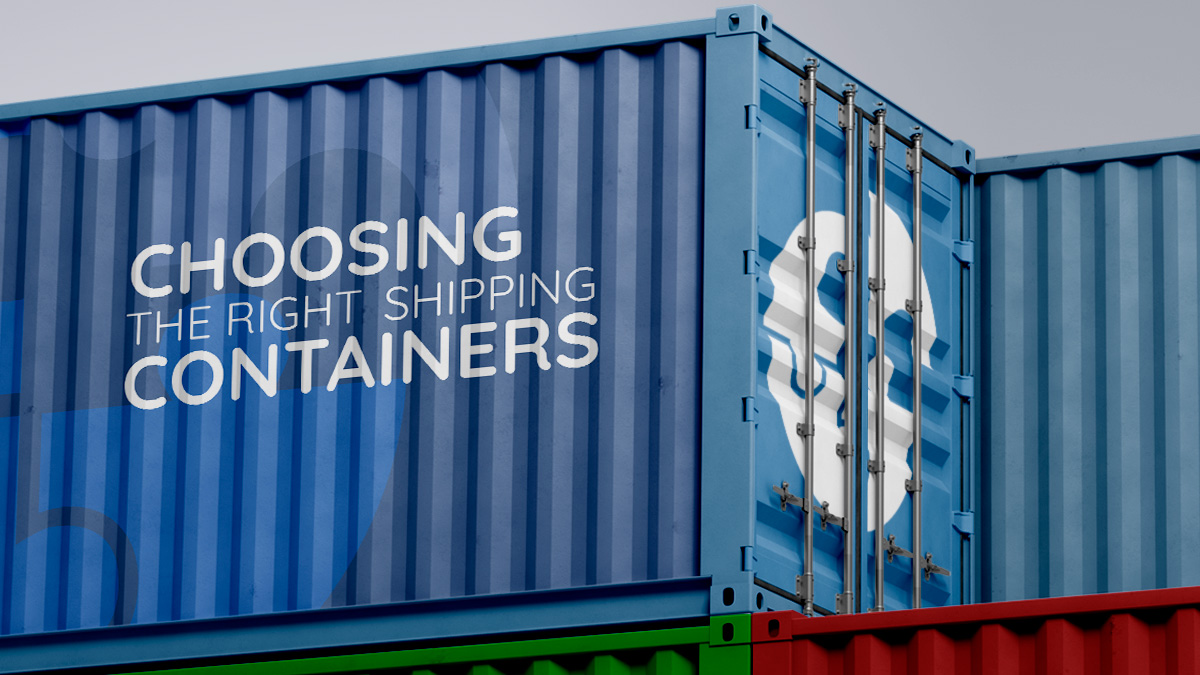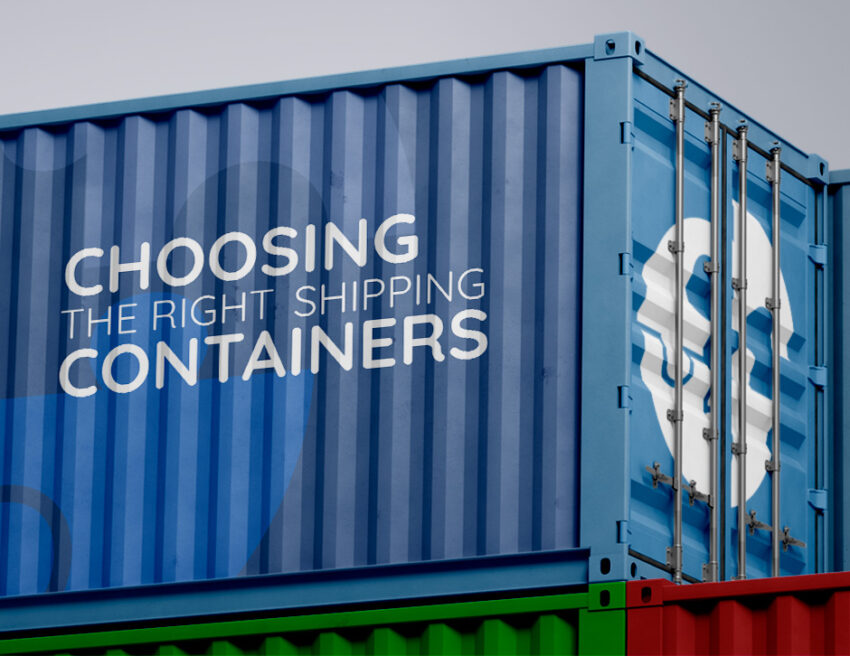Whether you’re moving cargo by sea, air, or land freight, the choice of shipping container plays a crucial role in the transportation process. While selecting a container may initially seem straightforward, there are several considerations you need to take into account to ensure it meets your specific requirements. Shipping containers come in various sizes and physical characteristics, making it essential for independent freight forwarders to carefully choose containers based on the type of cargo being transported. The selection process is crucial to ensure that the shipment arrives in the same intact condition as when it was loaded. In this article, we will provide a practical guide for independent freight forwarders on choosing the best containers for their shipping processes.
Factors independent freight forwarders should remember while selecting a container

Carefully consider the size of the container
When choosing a container, independent freight forwarders should opt for a size that best accommodates their specific cargo requirements.
The 20-foot or 1 TEU containers are commonly employed for shipping ocean freight, particularly well-suited for transporting heavy cargo rather than voluminous items. Examples of suitable cargo for these containers include metals, machinery, cement, steel rods/coils, sugar, and more.
On the other hand, the 40-foot or 1FFE containers are another prevalent type, more suitable for carrying voluminous cargo rather than heavy items. These containers are ideal for transporting cargo like steel pipes, paper, garments, furniture, and similar goods.
For cargoes that are not excessively heavy but require additional height, the 40 HC or 40 High Cube containers are the ideal choice. These containers, taller than the standard 40-foot ones, can carry more cargo and are specifically used for transporting tall items. However, caution should be exercised not to overload these containers, as they are not designed for carrying heavy goods.
Ensure that the shipping container is in good condition
Performing a thorough inspection of the shipping container is essential for ensuring the safe transport of your cargo. Look for any cuts or dents in the walls, keeping in mind that this inspection may be challenging from the inside. Be vigilant about suspicious-looking patches, as they could indicate rust. Rust can lead to significant damage to the top or roof rails, posing a potential threat to your cargo. Therefore, before renting or hiring a container, verify that the walls are free from dents or rust, and ensure the top rails are in optimal condition.
Additionally, pay close attention to the condition of the container doors. Confirm that the doors are in good shape, and inspect the gasket seals to ensure they are not damaged or broken. Damaged seals could pose a risk of water damage to the cargo during transit. A meticulous examination of these key aspects will contribute to the overall safety and integrity of your shipment.
Selecting a container that is ideal for the shipment you are moving
-
Containers for Out Of Gauge cargo
When dealing with the shipment of OOG (Out of Gauge) cargo, the choice typically lies between flat rack containers or open-top containers.
Open Top Containers
These containers are best suited for scenarios where your cargo exceeds the height limits of standard 20-foot or 40-foot containers but doesn’t require the extra height provided by a high cube container. While the top of these containers is not truly open, it is typically covered with tarpaulin. They facilitate convenient loading or unloading of shipments from the top using a crane.
Flat Rack Containers
Flat rack containers are characterized by a large horizontal metal frame, typically standing at around 10 feet in height and extending up to 60 feet or more in length. These containers are available in three main sizes: 20 feet, 40 feet, and 53 feet. Designed to accommodate heavy or oversized cargo that may not fit within standard shipping containers, flat rack containers are particularly useful for transporting bulky construction equipment, specific machinery or engines, wind turbines, and similar items.
These containers are also well-suited for situations where moving crates over uneven surfaces poses a challenge. Additionally, their design allows for easy transportation on open trucks or special trailers for road transportation. The versatility of flat rack containers makes them an ideal choice for various scenarios involving the movement of oversized or irregularly shaped cargo.
-
Containers for moving hazardous shipment
Independent freight forwarders tasked with transporting dangerous goods, such as hazardous liquids, gases, or radioactive materials, should opt for tank containers or IMO containers. The term “IMO containers” stems from the International Maritime Organization (IMO), which oversees the prevention of environmental hazards during the transportation of dangerous cargo.
These containers are designed with a cylindrical tank made of corrosion-resistant material, enclosed within a robust steel frame. Typically, they feature two or even three separate tanks, divided by partitions. It is crucial to note that tank containers carrying liquids may also include electrical components that require regular checks, and they must undergo annual certification by a third-party entity for compliance and safety assurance. This adherence to standards ensures the secure and environmentally responsible movement of hazardous materials.
-
Containers for perishable cargo
Refrigerated containers, commonly known as reefer containers, operate at temperatures significantly lower than standard containers. When shipping perishable goods such as pharmaceuticals, vegetables, meat, dairy products, flowers, etc., it is essential to select the appropriate reefer container equipped with a refrigerator and insulation to maintain the shipment within the required temperature range throughout the entire journey. Typically, these containers maintain a preset temperature, often around -10 degrees Celsius.
One notable feature of reefer containers is their large sliding doors, facilitating easy loading and unloading processes. Recent technological advancements have led to substantial improvements in the design of these containers, enhancing their safety and efficiency for the transportation of temperature-sensitive cargo.
-
Containers for transporting non-hazardous liquid
Non-hazardous liquids such as cooking oil, wine, beer, etc., are best transported using Flexitank containers. In this type of container, a large bag is fitted within a standard 20 feet container. This bag is filled with the liquid cargo and securely placed in the tank to prevent any movement during transportation. Flexitank containers offer a practical and efficient solution for shipping non-hazardous liquids in bulk, providing a contained and secure environment for the transport of such goods.
-
Container for moving high-value cargo
For shipping valuable cargo via sea freight, a recommended choice is a tunnel container. These dry freight containers feature two doors at each end, streamlining the loading and unloading processes, making them quicker and more efficient. Notably, tunnel containers are equipped with an additional layer of metal and special locks, enhancing their security features.
Due to these characteristics, tunnel containers are well-suited for transporting valuable or high-risk shipments, including items like high-value paintings or sculptures, precious metals, gems, and cash. Their design prioritizes both ease of access and enhanced security, making them an ideal choice for the transportation of valuable and sensitive cargo via sea freight.


